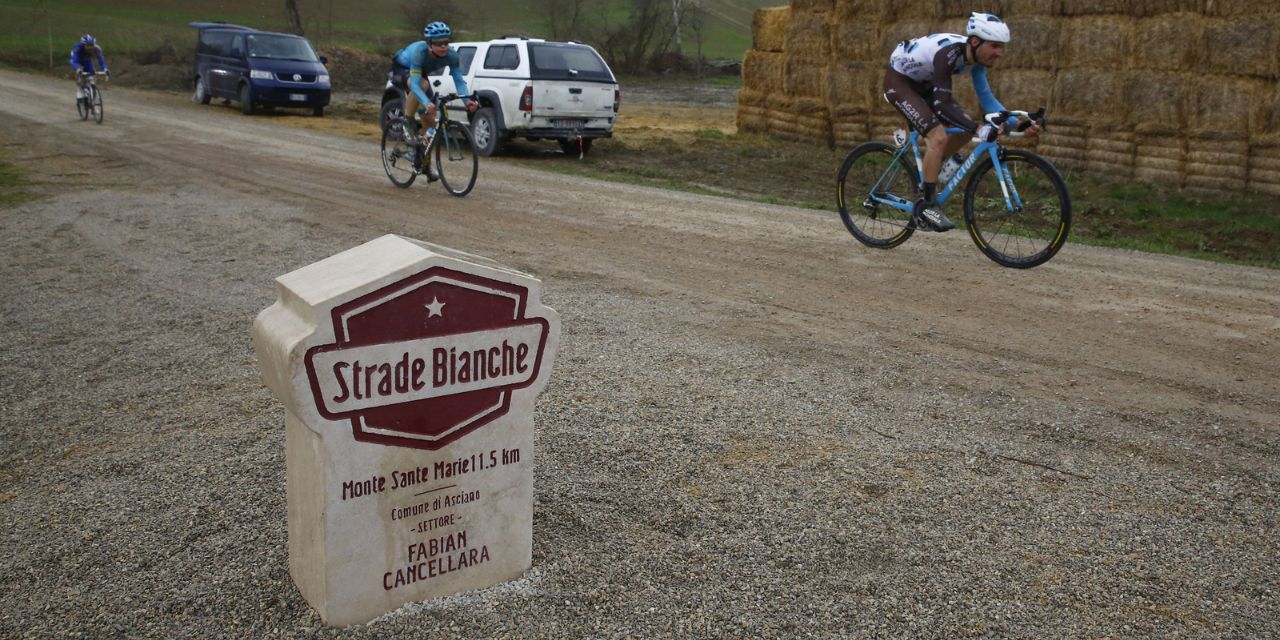With a 360° view sweeping from Chianti to Amiata and from Cetona to Montagnola, Monte Sante Marie is, thanks to its architectural and scenic merits, a site listed as a monumental heritage. Surrounded by a forest of centuries-old cypress trees, it is an ancient, fortified village probably founded by the Longobards, whose landscape is typical of the magnificent Crete Senesi area, a source of inspiration for artists, photographers, writers and filmmakers.
Monte Sante Marie is located right in the middle of the famous dirt road that bears its name and that constitutes the most spectacular and challenging section of the Strade Bianche, a key turning point of the race both physically and psychologically. It opens with a steep climb and it’s full gas from that point onwards. This is where both Tadej Pogačar and Tom Pidcock placed their decisive attacks in 2022 and 2023 respectively. It is an 11.5 kilometre torture for the riders: on top of the undeniable technical difficulties due to the non-stop ups and downs, the dust raised by the bikes ends up in the eyes and nose of those in the back, making it hard to see and breathe. As if that weren’t enough, let’s not forget that a good 4.5 km of the 11.5 km of Monte Sante Marie are uphill, with gradient peaks of up to 18%.
This would be enough to explain why Monte Sante Marie has always played such a decisive role in the history of the Strade Bianche. We should also add that, until the 2023 edition, this section was tackled with only 54 km to go, when the riders’ legs had already done their fair share of hard work in the dust. Even when the decisive attack did not arise, something crucial and exciting would never fail to happen. One of the most memorable editions was that of 2021, the one won by Mathieu Van der Poel with the powerful attack on the wall of Via Santa Caterina in Siena. Still, fans will also remember the great tussle on the gravel road of Monte Sante Marie, at the end of which a five-star group featuring Van der Poel, Wout Van Aert, Tadej Pogačar, Julian Alaphilippe, Tom Pidcock and Egan Bernal formed. A clash of titans that fans could only dream of.
However, with the route change designed for the 2024 edition, the location of Monte Sante Marie within the race will be a little different from what we are used to. This devastating white sector, in fact, will end at 72.5 km from the finish, thus about 18 km further away from the traditional location. The change of strategy among the various teams will be one of the most interesting things to find out. Should the riders tackle this section with the usual energy or approach with a little more care and strategy, one thing is for sure: there is no hiding from Monte Sante Marie.
Monte Sante Marie si trova proprio a metà della famosa sterrata che porta il suo nome e che, unendo le antiche vie Scialenga e Lauretana, costituisce il tratto più spettacolare e impegnativo della Strade Bianche. Proprio lì è nata l’azione decisiva che ha permesso a Tadej Pogačar di vincere l’edizione 2022 e lì si è sviluppato l’attacco di Tom Pidcock, vincitore lo scorso anno. Sono 11,5 km di tortura per i corridori, perché se non sei davanti sei accecato dalla polvere alzata dalle biciclette, la stessa che sei obbligato a respirare, e a tutto ciò si unisce la difficoltà tecnica di guidare sullo sterrato e il dislivello. Degli 11,5 km di fuoristrada di Monte Sante Marie, infatti, ben 4,5 km sono in salita, con punte di pendenza che toccano anche il 18%.
Basterebbe quindi questo a spiegare perché Monte Sante Marie sia sempre risultato così decisivo nella storia delle Strade Bianche, ma va aggiunto che, fino all’edizione del 2023, veniva superato a soli 54 km dall’arrivo, quando i corridori avevano già 130 km di su e giù per le strade e gli sterrati senesi. Anche quando magari non è nato l’attacco decisivo, c’è sempre stata la scrematura decisiva, quella che riduceva il gruppo a quei 10-15 corridori che si sarebbero poi andati a giocare la vittoria. Una delle edizioni più memorabili è stata quella del 2021, quella vinta da Mathieu Van der Poel con la celebre staffilata sul muro di Via Santa Caterina a Siena, ma gli appassionati si ricorderanno anche la grande bagarre sullo sterrato di Monte Sante Marie, al termine del quale si formò un gruppetto a 5 stelle, con Van der Poel, Wout Van Aert, Tadej Pogačar, Julian Alaphilippe, Tom Pidcock e Egan Bernal. Uno scontro tra titani, un tutti contro tutti che, così al completo, non si è più visto dopo quell’edizione della Strade Bianche.
Con il cambio percorso studiato per l’edizione del 2024, però, la collocazione di Monte Sante Marie sarà un po’ diversa da quella a cui siamo abituati. Il difficile settore bianco, infatti, terminerà a 72,5 km dall’arrivo, quindi circa 18 km più lontano dalla collocazione classica. Non solo, se prima c’erano “solo” 3 tratti di sterrato dopo Monte Sante Marie prima di andare all’arrivo, ora ce ne saranno 7. Sarà quindi interessante vedere se i corridori decideranno di affrontarlo alla garibaldina come hanno sempre fatto oppure, vista la distanza da Piazza del Campo, prevarrà una maggiore prudenza, in attesa dell’anello con il doppio Colle Pinzuto e Le Tolfe. Anche se dovessero affrontarlo un po’ più piano rispetto al solito, ciò non toglie che il gruppo ne uscirà fortemente segnato e qualche indicazione su chi potrebbe vincere la Strade Bianche 2024 le avremo comunque. Su questo siamo certi, non ci si può nascondere da Monte Sante Marie.

































